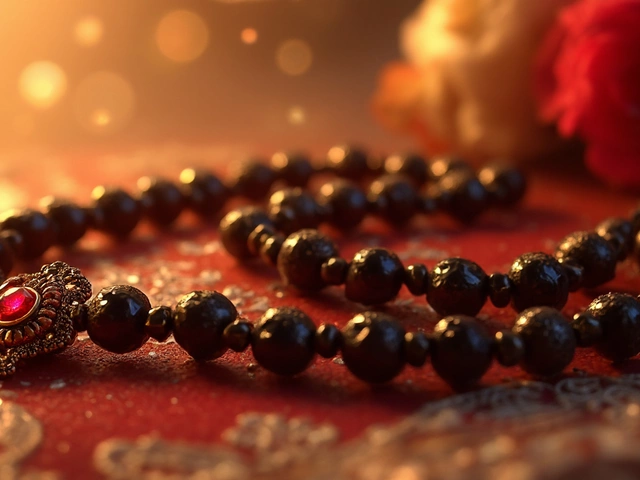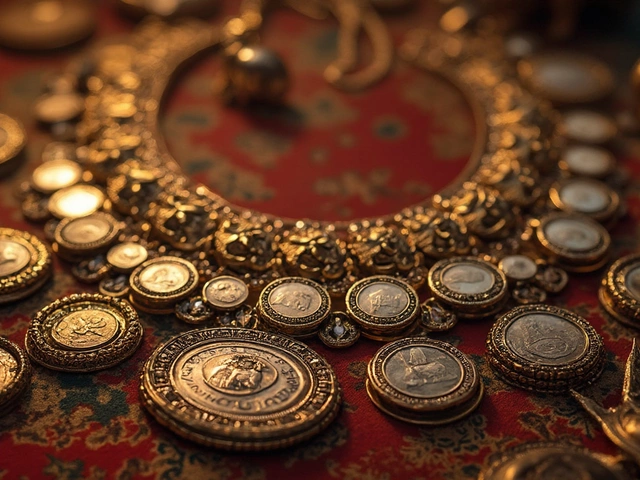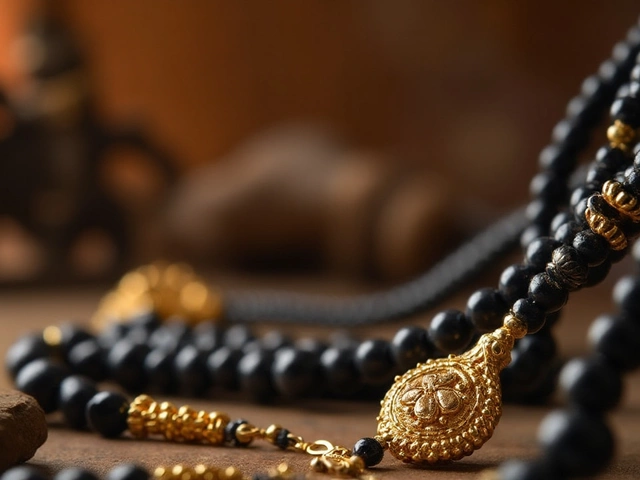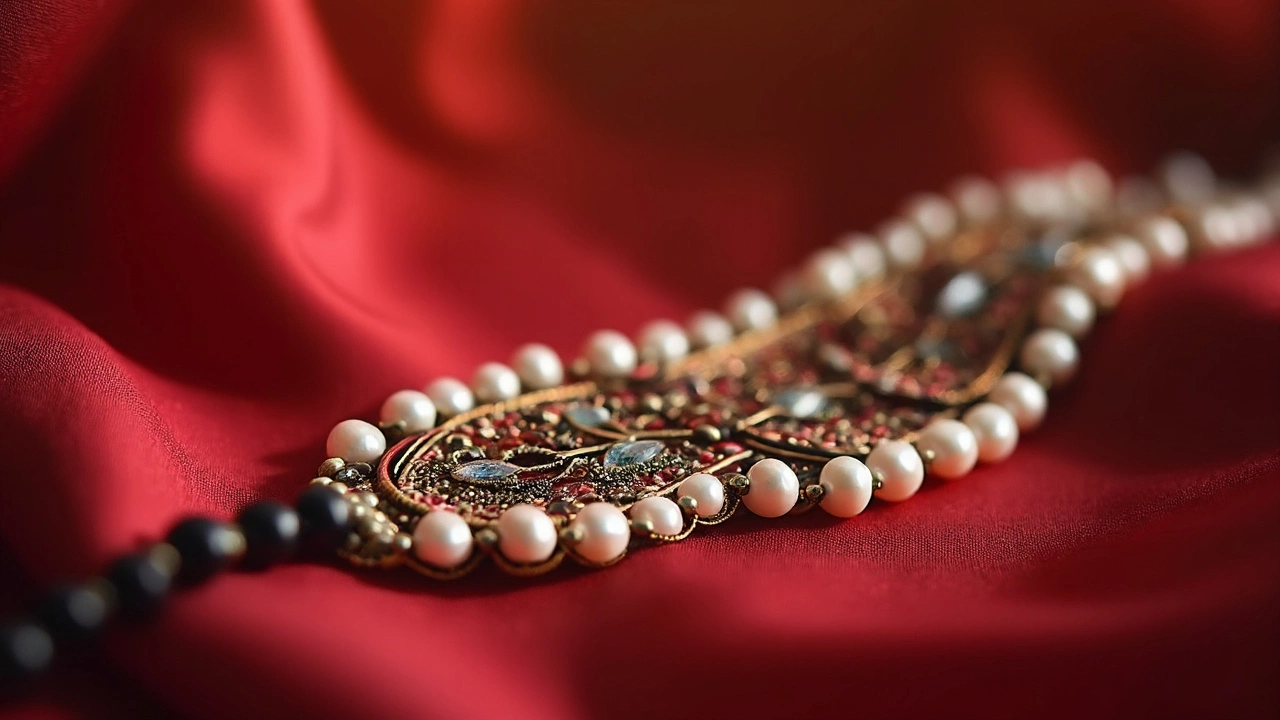
You ever wonder why those little white pearls, known as moti, are a big deal in mangalsutra designs? It's like they're the unsung heroes adding a touch of elegance and tradition to a piece of jewelry that's already packed with meaning. In India, they aren't just decorative; they hold deep roots in cultural significance and spiritual symbolism.
Moti stand for purity and new beginnings, and that might be why they resonate so well with the idea of marriage. Back in the day, pearls were precious in more than just the financial sense. They meant balance, completeness, and wisdom—values that hit home in any relationship. Plus, they catch the light in a way that’s effortlessly classic, which never goes out of style.
- What is White Moti?
- Symbolism and Significance
- Historical Roots and Evolution
- Modern Trends in Mangalsutra Designs
- Choosing the Right Design
- Caring for Your Moti-Studded Mangalsutra
What is White Moti?
White Moti, often referred to simply as pearls, are little marvels created by nature. They’re made inside the shells of certain mollusks, usually oysters or mussels. Interestingly, the beauty of a pearl starts when an irritant, like a bit of sand, gets inside the shell. The mollusk then covers this irritant with layers of nacre, creating the smooth and lustrous stone we know as a pearl.
Now, you might wonder, why white? Well, in mangalsutra designs, the white moti brings a sense of purity and elegance that complements the deep significance embedded in this jewelry. The white color is associated with purity, peace, and innocence, making it a perfect match symbolically for something tied to marriage, commitment, and love.
Pearls come in various shapes and sizes. Some may notice that not all pearls are perfectly round. There are baroque pearls—those that are irregularly shaped but equally beautiful. It's these little imperfections that often add character and uniqueness to a mangalsutra, making each piece feel a bit personal.
Despite their seemingly delicate appearance, good quality pearls are quite durable. They’ve been prized across cultures for thousands of years, not just for their beauty but also for their perceived aphrodisiac properties back in ancient times. Wearing pearls, especially in the form of an adornment like a mangalsutra, connects you to a rich tradition of appreciating nature's wonders.
Symbolism and Significance
When it comes to a mangalsutra, the inclusion of white moti isn’t just for show. These pearls carry a freight-load of symbolism. In many cultures, pearls are seen as emblems of purity and innocence. So, tossing these into a piece of jewelry that's all about love and commitment? It's like hitting a home run in the symbolism department.
Beyond purity, these little gems speak to the idea of balance and perfection. Think about it: a perfectly round pearl stands for something whole and complete, much like what you want in a relationship. There’s an old belief that pearls help calm the mind and bring about tranquility, which is exactly what you need when balancing a lifelong partnership.
Then there's the cultural angle, especially in the Indian context. Moti in a mangalsutra also symbolizes protection. It's a bit like having a tiny guardian angel hanging right there with you. This protective trait aligns well with the fact that the mangalsutra itself is considered a shield, safeguarding the bond of marriage.
The significance of white moti in a mangalsutra might also stretch way back into history. Ancient texts suggest pearls were worn by deities to embody celestial and divine perfection. Imagine the kind of weight that carries over centuries, setting the vibe for modern-day designs.
So when you're choosing a mangalsutra, understanding the role of white moti helps in appreciating the depth they add. It's about wearing a piece that has, quite literally, a history of meaning woven into every inch.
Historical Roots and Evolution
The journey of the white moti in mangalsutra designs is pretty fascinating. These petite pearls have been lacing their elegance into jewelry for centuries, long before modern styles took over. Moti, or pearls, were highly prized in ancient India, often seen as a symbol of beauty and status. They were the choice of royals and the elite, adding a touch of sophistication to any ornament.
The use of pearls in a mangalsutra wasn't just about their aesthetic appeal. In the past, they were believed to bring about a sense of peace and calm due to their soothing nature. They complemented the black beads of the mangalsutra, which were thought to ward off negative energies. Pairing moti with these beads was not just about beauty; it was about balance.
As we hopped into the 20th century, the designs started getting more varied. Different regions in India brought their unique twist to the mangalsutra. In South India, for instance, large and bold motifs with moti were preferred, whereas Northern designs leaned towards intricate and delicate patterns.
Today, while diamonds and gold embellishments have found their way into mangalsutra designs, white moti still hold their charm. They maintain that classic elegance that manages to feel both traditional and modern. With the rise of minimalist designs, these pearls offer an understated elegance that's hard to beat.
White moti has evolved its way through changes in trends but has managed to keep their place in the heart of mangalsutra designs across ages. It remains a testament to how something so simple can carry such profound beauty and tradition.
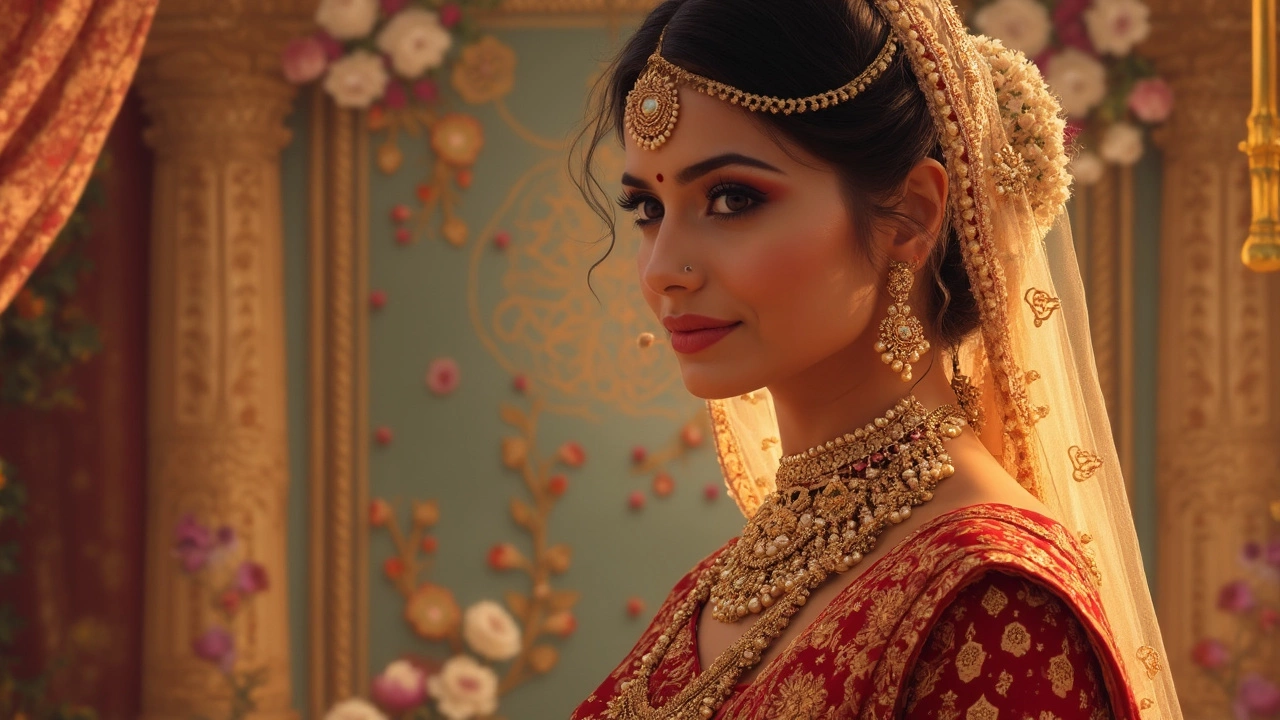
Modern Trends in Mangalsutra Designs
When it comes to keeping things fresh in the world of mangalsutra designs, today's trends are all about mixing tradition with a splash of modern flair. You see, gone are the days when mangalsutras were just bulky chains loaded with black beads. Now, they're sleek, stylish, and totally customizable while still honoring their roots.
White moti are making waves in these designs for a good reason. Their clean and elegant look appeals to the modern bride who's into minimalism but still wants that traditional touch. Designers are pairing these pearls with different metals—yellow gold, white gold, and even rose gold are in the spotlight to create unique contrasts.
Another cool trend is the inclusion of charms and pendants. Couples today are choosing symbols that mean something special to them—could be their star signs, initials, or something personal that tells their unique story. These little touches make the mangalsutra not just a piece of jewelry, but a sentimental item too.
Also, the classic long chains are seeing a length variation. Some brides opt for shorter versions, which are super practical for everyday wear, while others still love the traditional longer look. A lot of these modern designs are built with layering in mind, perfect for wearing with Western outfits or even layering with other necklaces.
With recent shifts towards ethical jewelry, there's also a trend for responsibly sourced materials. People are more conscious about where their pearls and metals come from, adding a feel-good factor to their buy.
| Design Element | Current Trend |
|---|---|
| Metal Choices | Yellow, White, Rose Gold |
| Chain Length | Short and Long Variations |
| Customization | Personalized Charms and Pendants |
| Moti Style | Emphasis on Simplicity and Minimalism |
No matter how you twist it, the modern mangalsutra embraces change without losing the essence of its origin, making it a perfect blend of new and old, just like what every couple aims for in their journey together.
Choosing the Right Design
Alright, so you're on the hunt for the perfect mangalsutra design featuring those elegant white moti, huh? Don't worry, it's not as tricky as it seems. First, think about what vibe you're going for. Are you into something traditional, or do you lean towards a modern twist?
If you're all about tradition, you might want to check out designs that have intricate gold patterns with the pearls. You can never go wrong with classic combinations. They exude a sense of timelessness, and the white moti usually take the center spot with their purity and brightness in these designs.
Looking for something a bit more contemporary? Try going for a sleek design with minimalist chains and strategically placed white moti. These modern mangalsutras are great if you're looking for something that pairs up well with both ethnic and western outfits.
Here's a thing you might not know: the length of the chain matters a lot. The standard is usually around 16 to 18 inches, but if you prefer a more laid-back style, a longer chain might suit you. Always try it on to see how it sits on you because comfort is key.
- Check the Quality: Always ensure that the pearls are well set and not glued. A loose jewel is the last thing you want when you're in the middle of festivities.
- Mind the Gold Weight: A heavier mangalsutra could feel bulkier, so find a balance between style and weight that you're comfortable with.
- Customization: If off-the-shelf designs don't cut it for you, many jewelers offer customization. You can add a personal touch, like initials or a small charm.
And let's not forget the budget! Price points can vary hugely based on the brand and materials. While pearls are generally affordable, the gold used can make a serious dent in your wallet. Have a price range in mind and stick to it, unless you find something that's an absolute must-have!
There's a certain charm in finding the mangalsutra that speaks to you. The best advice? Take your time, try different styles, and let the perfect design find you. Whatever you decide, those pearly moti will always add that extra sprinkle of grace and significance.
Caring for Your Moti-Studded Mangalsutra
You've got this beautiful moti-studded mangalsutra hanging around your neck, and trust me, taking good care of it will keep it looking regal for ages. While they might look delicate, keeping those pearls shiny and bright isn't rocket science.
First up, avoid direct contact with chemicals. Perfumes, hair sprays, and even some lotions can dull the shine and might even damage the pearls over time. A basic rule? Always put on your jewelry after you're ready to head out, not before.
Also, remember the golden rule when it comes to white moti—pearls like to breathe. Keep them in a soft cloth pouch or a fabric-lined jewelry box, away from other jewelry pieces that might scratch them. Don't just chuck them into a pile of jewelry.
For cleaning, it's pretty straightforward. Use a soft, damp cloth to gently wipe the pearls. No harsh detergents or scrubs—just a bit of water will do. If your pearls need a deeper clean, a mild soap solution can be used sparingly. Rinse thoroughly with clean water to make sure no soap is left behind, and dry them with a soft cloth.
- Handle the pearls with care.
- Store separately to avoid scratches.
- Clean with a damp, soft cloth.
- Avoid chemicals at all costs.
A little effort goes a long way. Think of caring for pearls as one of those small but satisfying tasks. It's like looking after your favorite houseplant; it doesn't need much, but regular attention makes all the difference. And hey, who doesn't love keeping their traditional jewelry looking like it just came out of the box?
